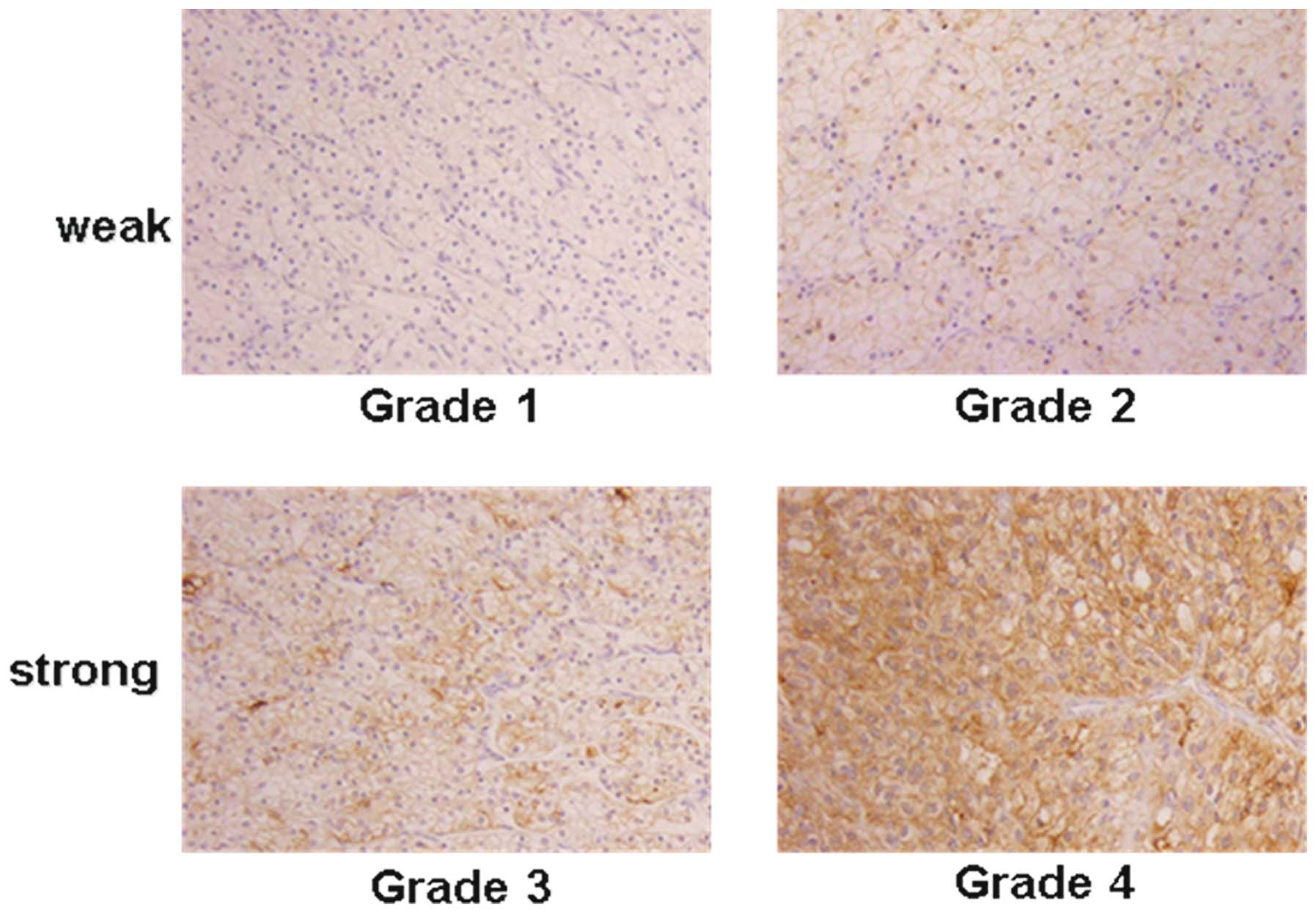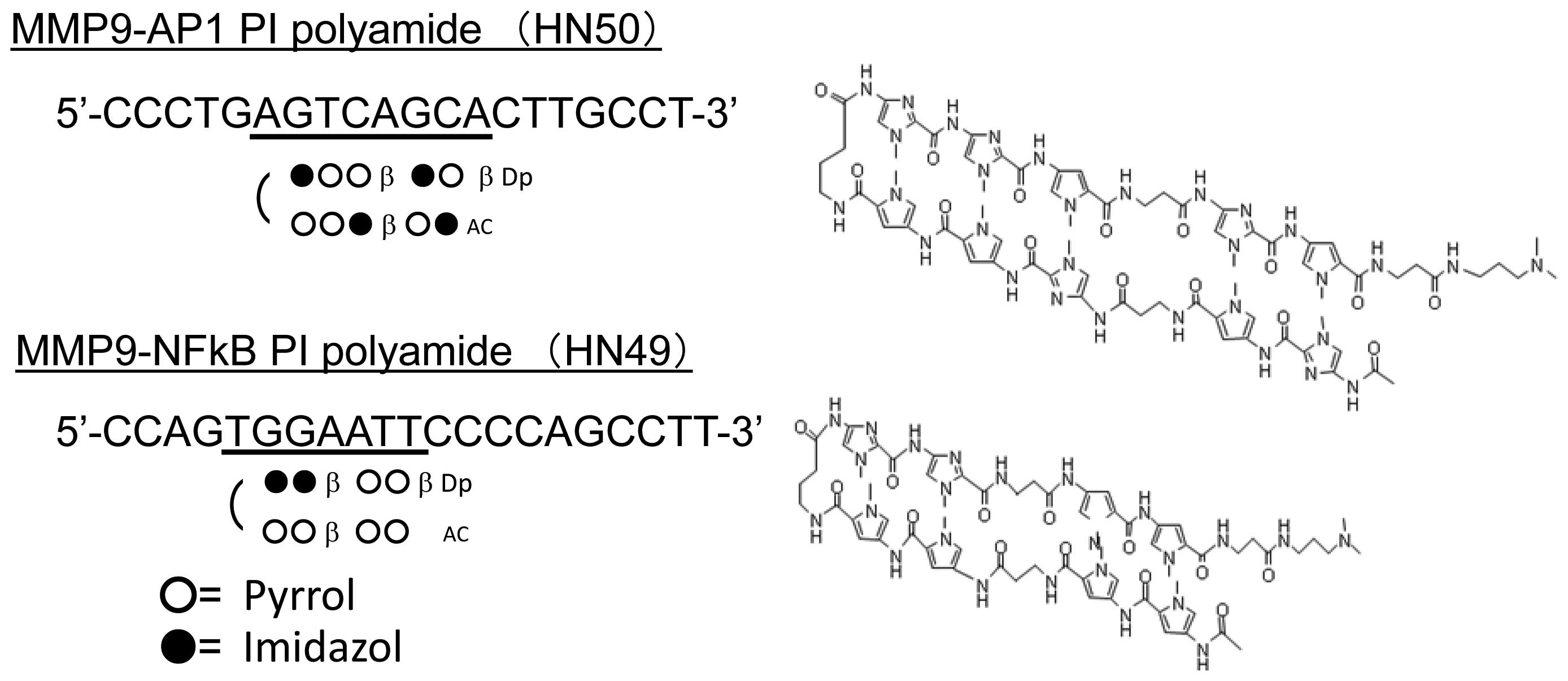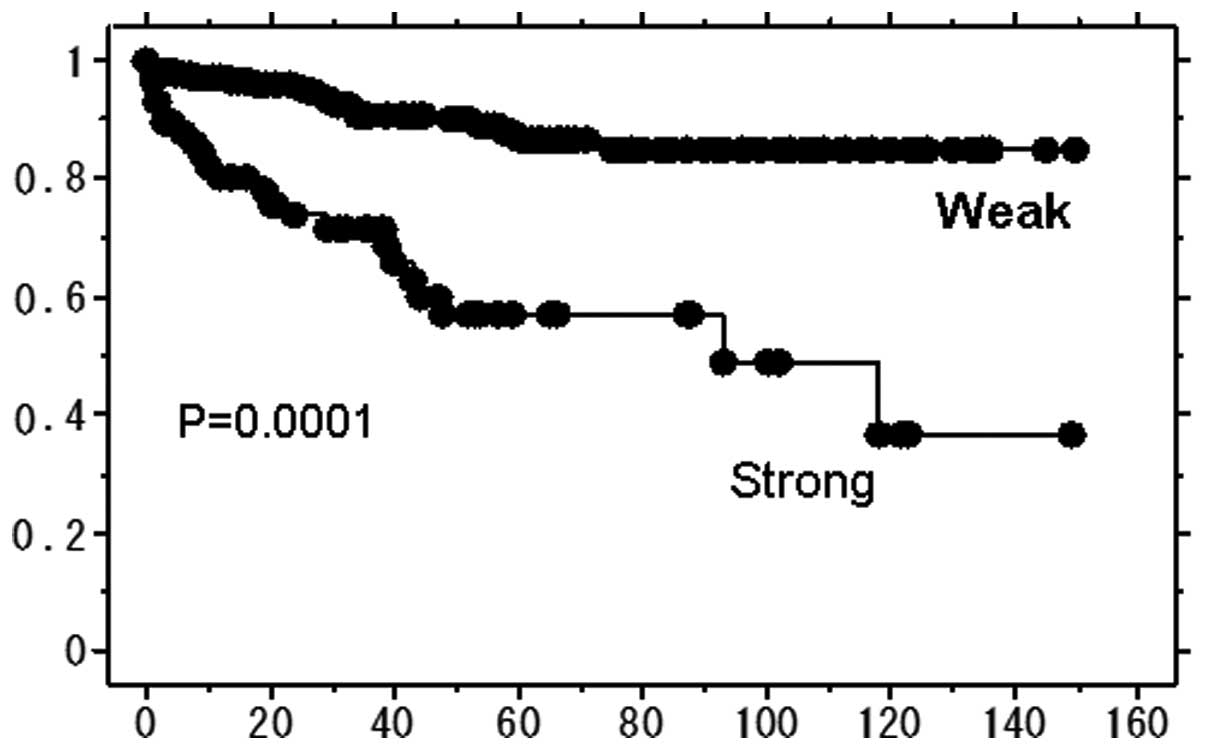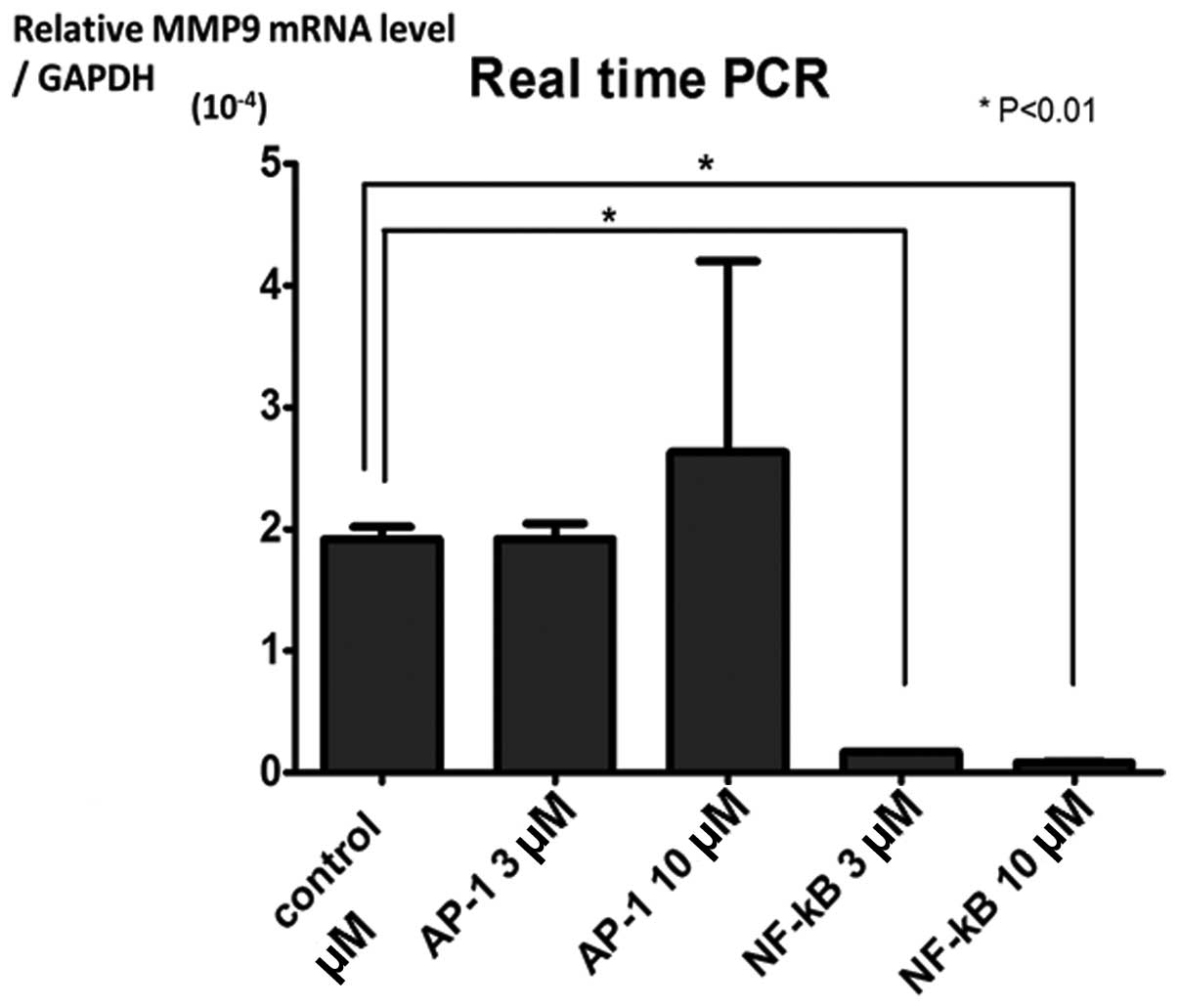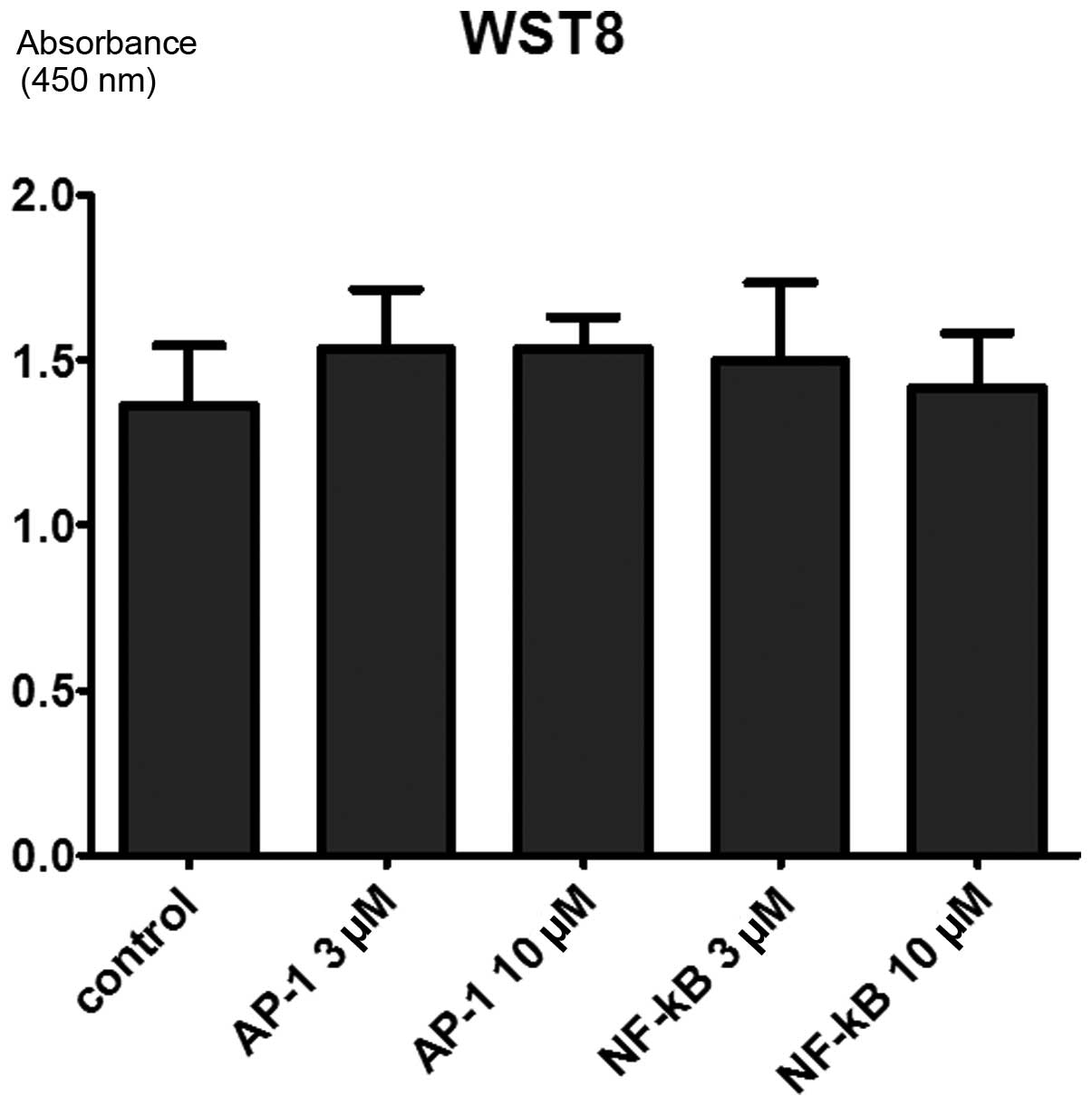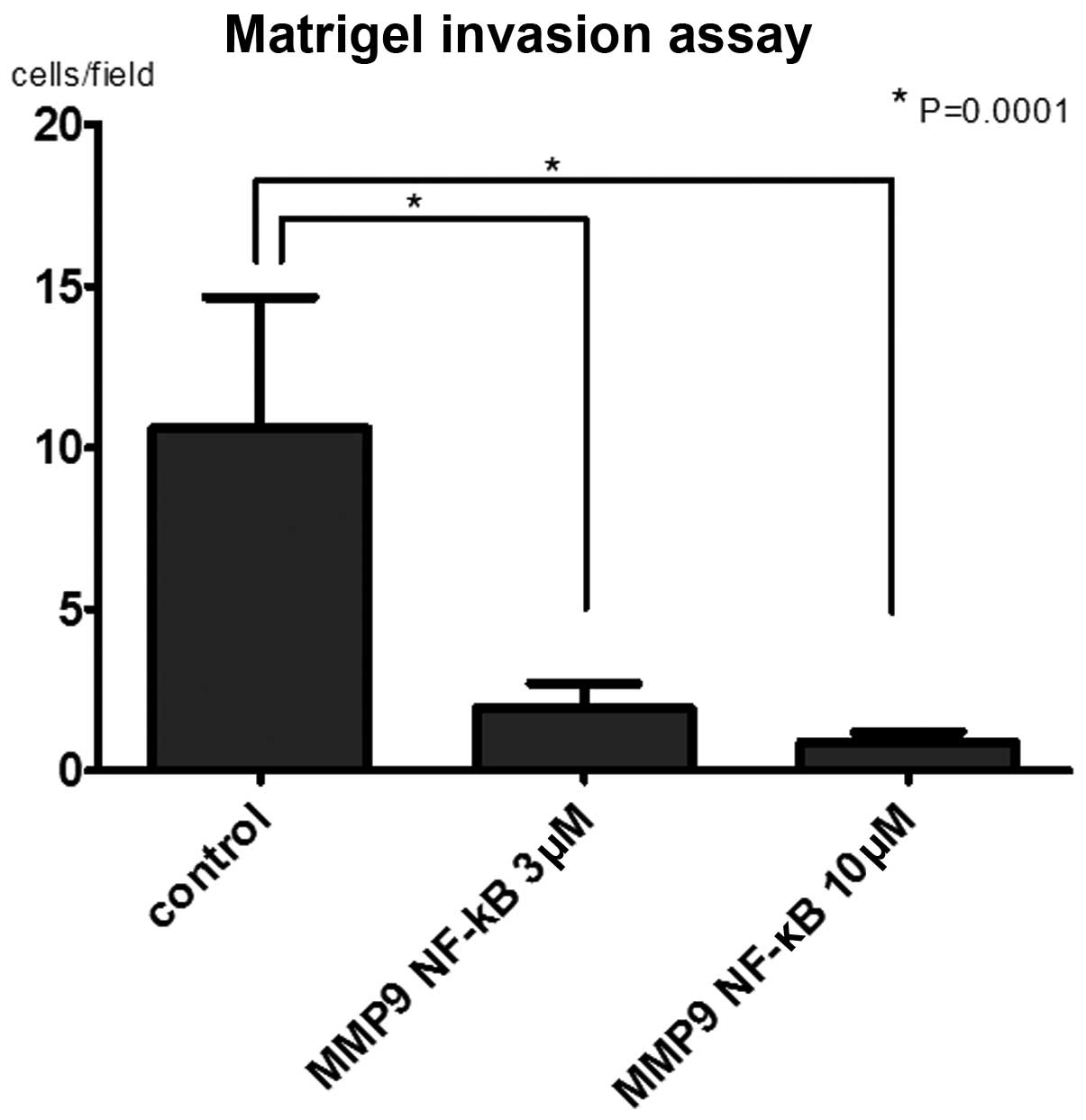Inhibition of MMP-9 using a pyrrole-imidazole polyamide reduces cell invasion in renal cell carcinoma
- Authors:
- Published online on: August 21, 2013 https://doi.org/10.3892/ijo.2013.2073
- Pages: 1441-1446
Abstract
Introduction
New agents including the small molecule targeted inhibitors like sunitinib, sorafenib and temsirolimus, for advanced renal cell carcinoma (RCC) have been developed based on a biological process in the RCC carcinogenesis. However, they are often accompanied by adverse effects that occasionally require dose reduction or discontinuation. Tenacious cancer cells subsequently become resistant to the same drug treatment. Therefore, development of new molecular targeting agents as novel targets with minimal adverse effects is still needed (1–3).
The permeation to basement membrane and the extracellular matrix of neoplastic cells is regarded as the most important step in metastatic process. MMP is a group of enzymes that degenerate various elements of extracellular matrix including elastin, gelatin, agrican, fibronectin and laminin (4,5). Further more, an impact of MMP on the early proliferation of tumor cells of metastatic focus has been reported. In addition, tissue inhibitor of MMP (TIMP), which is an endogenous MMP inhibitor participates in the activity of MMP and disproportion between TIMP and MMP modulates the progression of tumors (6,7).
Among these MMPs, MMP-9 degenerates type IV collagen, gelatinized types I and II collagen and participates in the permeation of basement membrane by tumor cells. The expression of MMP-9 is increased in malignant tumors in comparison with benign or non-invasive tumors (7,8). In addition, overexpression of MMP-9 is confirmed in renal cell carcinoma (8–12). Kawada et al reported association of MMP-9 expression and poor prognosis using clinical specimen of renal cell carcinoma (13,14). Therefore, we expected the new therapeutic drug that inhibits activity of MMP-9 may have an antitumor effect for renal cell carcinoma.
Pyrrole-imidazole polyamides (PIP) are powerful gene regulating compounds, which can bind to the minor groove of DNA double strand in a sequence-specific manner. They are composed of two aromatic amino acids [N-methylpyrrole (Py) and N-methylimidazole (Im)]. The combination of Im/Py recognizes GC in the DNA double-helix, Py/Py recognizes TA and AT and arrangements of these combinations made it possible to bind to a variety of sequence. Since they can bind DNA with higher affinity and specificity than the usual DNA binding proteins, PIPs designed to recognize the binding domain of transcription factors could inhibit the expression of downstream genes. Precise binding to a known sequence may make it possible to reduce adverse events, therefore PIP is expected to become a new molecular targeting agent (15–18). Previously, we reported that PIP targeting for MMP-9 inhibit the migration and invasion of colon cancer cells in vitro and also inhibits their metastasis in vivo (19).
In the present study, we examined MMP-9 immunore-activity in clinical specimens and analyzed the degree of association and matched cancer-specific survival. Furthermore, we investigated effects of PIP on the inhibition of MMP-9 expression and resulting inhibition of cellular invasion by using human renal cell carcinoma cell line Caki-2.
Materials and methods
Tissue samples
Two hundred and forty-nine surgical samples with informed consent were obtained at Surugadai Nihon University Hospital from 1990 to 2003 (Table I). All of the studies using these specimens were performed under the approval of Nihon University School of Medicine Ethics Review Board (IRB no. 106-1).
Immunohistochemistry
Immunostaining for MMP-9 were performed and the degree of immunoreactivity was analyzed to find the association between cancer-specific survival by using Kaplan-Meier method with log-rank test. For immunostaining, formalin-fixed, paraffin-embedded 4-μm thick samples placed on silane coat slide glass (Dako, Carpinteria, CA, USA) were used. After, retrieval with 500 W microwave, slides were processed with 3% hydrogen peroxide and 5% non-fat milk phosphate buffered saline (PBS) to block non-specific antibodies. Rabbit polyclonal matrix metalloproteinase-9 antibody (Cell Signaling Technology, USA) was used as a primary antibody. Afterwards, samples were visualized by simple stain MAX-PO (Nichirei, Tokyo, Japan). The staining intensity of MMP-9 was stratified using a 4-grade scale, with grade 1 indicating the absence of immunostaining or faint membranous staining of rare tumor cells, grade 2 indicating membranous staining in most tumor cells, grade 3 indicating diffuse membranous and/or cytoplasmic staining in groups of tumor cells and grade 4 indicating significant cytoplasmic staining in most tumor cells (Fig. 1). For the evaluation of immunohistochemical staining, intensities of grades 1 and 2 were considered weak expressions of each protein, whereas grades 3 and 4 were considered strong.
Synthesis of PIP targeting human MMP-9
The expression of MMP-9 gene is known to be regulated by the transcription factors NF-κB, AP-1, Sp1, whose binding sites are located within 2.2 kbp upstream from transcription start site. We designed and synthesized two PIPs targeting MMP-9-NF-κB binding site (−600 to −605) and MMP-9-AP-1 binding site (−70 to −77) (Fig. 3). In each experiment, we diluted them in dimethyl sulfoxide (DMSO) to make 10 mM stock solutions.
Cell lines and culture conditions
The human renal cell carcinoma cell line Caki-2 was kindly transferred from Dr Cowell (Roswell Park Cancer Institute, NY, USA) and cultured in McCoy’s 5A (Invitrogen Life Technologies, CA, USA) supplemented with 10% FBS (McCoy’s5A FBS PS), 100 U/ml penicillin, 100 μg/ml streptomycin and non-essential amino acids (0.1 mM) under conditions of 5% CO2, 37°C.
Real-time RT-PCR
Cells/well (5.0×103) of Caki-2 cells were plated in 6-well plates and cultured for 24 h. Then PIPs were applied to the wells at the final concentration of 3 or 10 μM. No compound was applied to the negative control cells. After 48-h culture, the cells were washed with PBS and dissolved in TRIzol reagent (Invitrogen Life Technologies), then RNA was extracted following the manufacturer’s instructions. After the treatment with DNase, first-strand cDNA was synthesized using iScript (Bio-Rad, Hercules, CA, USA) and real-time RT-PCR was carried out using SYBR Premix Ex Taq, Perfect Real-Time (Takara Bio, Otsu, Japan). The primers used in the real-time PCR to detect human MMP-9 were 5′-GAGACCGGTGAGCTGGATAG-3′ (forward); 5′-TACACGCGAGTGAAGGTGAG-3′ (reverse) and for human GAPDH were 5′-GCACCGTCAAGGCTGAGAAC-3′ (forward); 5′-TGGTGAAGACGCCAGTGGA-3′ (reverse). The relative quantity of the MMP-9 expression level was normalized by the expression level of GAPDH.
In vitro cell proliferation
Cells were seeded on 96-well micro-plates at the concentration of 3.0×103 cells per well and cultured at 37°C in 5% CO2. Afterwards, cells were incubated for 72 h in the presence or absence of PIPs. Cell viability was evaluated by WST-8 (Nacalai Tesque, Japan) assay, in which absorbance at OD 450 nm was measured using with Wallac 1420 counter (Amersham Bioscience, Piscataway, NJ, USA).
Matrigel invasion assay
Invasion assay was carried out using BioCoat Matrigel invasion chambers (Becton-Dickinson Labware Co., MA, USA). Cells were suspended in culture medium at the concentration of 6.0×103 cells/ml and 500 μl of the suspension was seeded on the upper chamber. The lower chamber was filled with 500 μl of the culture medium without cells. Cells were incubated for 48 h with or without PIPs. After removing non-invasive cells with a cotton swab, invasive cells adhering to membrane of the upper chamber were fixed and stained with Diff-Quick solution. Number of the cells on the membrane was counted under a light microscope at ×200 magnification. The counting was done for 10 fields per each membrane.
Statistical analysis
All values are expressed as the mean ± SE and the statistical significance was analyzed using the Student’s t-test. A P-value of <0.05 was considered statistically significant.
Results
Immunohistochemistry
Two hundred and forty-nine of RCC specimens were subjected to immunohistochemical analysis to detect MMP-9 expression. One hundred and ninety-four out of 249 specimens (78%) were classified to weak and 55 (22%) to strong MMP-9 expression. Significant association was seen in a cancer-specific survival rate with the strength of the staining (Fig. 2). Patients in the strong stain group showed shorter survival than those in the weak group.
Expression of MMP-9 in MMP-9-PIP treated cells
We tested the expression level of MMP-9 in the cells treated with or without MMP-9 PIPs. The cells treated with 3 or 10 μM of MMP-9-NF-κB PIP showed significantly lower expression level than that of control cells (P<0.01) (Figs. 3 and 4). Even though the tendency of dose-dependency of MMP-9-NF-κB PIP in the suppression of MMP-9 expression was observed, no significance was attained between 3 and 10 μM (Fig. 4).
Cell proliferation in MMP-9-PIP treated cells
Cell viability was tested by WST8 assay 72 h after PIPs administration, however, no significant difference was found among the cells treated with MMP-9-NF-κB PIP, MMP-9-AP-1 PIP and the control cells (Fig. 5). This result indicates that MMP-9 PIPs do not affect cell viability and proliferation activity.
Invasion assay for MMP-9-PIP treated cells
To evaluate the effect of PIPs on cell invasion activity, matrigel invasion assay was performed. The number of invaded cells in MMP-9-NF-κB PIP treated group were significantly lower than in control group (P<0.0001). Even though the tendency of dose dependency of MMP-9-NF-κB PIP in the suppression of MMP-9 expression was observed, there was no significant difference between 3 and 10 μM (Fig. 6).
Discussion
In the present study, we confirmed an association of MMP-9 immunoreactivity and the cancer-specific survival rate by using clinical specimens. The patients with stronger immuno-reactivity of MMP-9 showed shorter survival than patients with weaker immunoreactivity. The result suggests the importance of MMP-9 in survival of RCC patients. Moreover, Kawata et al suggested an association of MMP-9 expression between high nuclear grade (13) and systemic symptoms (14) in clinical cases of RCC. We also confirmed a similar tendency in this study (data not shown).
Some reports concerned an antitumor effect by reducing activity of MMP-9. They reduced MMP-9 expression using shRNA against co-regulator of the nuclear receptor for ovarian cancer proline-, glutamic acid-, leucine-rich protein-1 (PELP1) (20), or a monoclonal antibody against heat shock protein 90 (HSP90) of breast cancer cells (21). These reports confirmed an antitumor effect of MMP-9 in animal experiments. Our result and those reported encouraged us to develop PIPs targeting MMP-9.
We found suppressed expression of MMP-9 mRNA in Caki-2 cells after the PIP administration possibly by inhibiting transcription factor binding at the promoter domain. Though MMP-9-AP-1 PIP is reported to have suppressive effect in the cell lines of breast cancer, colon cancer and cervical cancer (19), only MMP-9-NF-κB PIP showed suppression in the Caki-2 cell line. We presumed that mechanisms of the expression control vary among the cell types. Therefore, when designing PIP, detailed analysis of target gene transcription regulation is necessary to select an appropriate transcription factor for inhibition in each tumor and tumor type. Effective PIP may be decided from a candidate regulation domain of the targeting gene promoter.
For the evaluation of invasiveness of tumor in vitro, we performed Matrigel invasion assay, which has been commonly used to test cell invasion activity (22–24). We found that both 3 and 10 μM of MMP-9-NF-κB PIP restrained cell invasiveness significantly in comparison to control. These results were compatible with the result of the analysis of MMP-9 mRNA expression level, suggesting that MMP-9-NF-κB PIP reduce the cell invasiveness by suppressing MMP-9 expression. Since Matrigel includes two of the major components of basement membrane, laminin and collagen IV, this result suggested the possibility to control cell invasion by administration of MMP-9-NF-κB PIP in the tissue.
The cell proliferation ability showed no significant difference between PIP treated group and control. The result does not contradict the fact that the main role of MMP-9 is degeneration of basement membrane and it is not directly participating in cell proliferation. However, Bauvois reported MMP-9 is not only involved in cell invasion but in cell proliferation and vascularization by an interaction of growth factor, cytokine and vascularization factor (25). Therefore, future studies are necessary including experiments concerning effects of MMP-9-PIP other than suppression of invasion.
We reported previously the in vitro and in vivo effect of MMP-9-PIP on breast cancer and colon cancer cell line (19). In the mouse model, intravenous injection of MMP-9 PIP clearly inhibited colon cancer metastasis to the liver. In that study, we also found that PIP remains in the cell nuclei for at least 6 days suggesting a continuous PIP effect. Antisense DNA or RNAi requires an adequate drug delivery system because it is easily disintegrated by nucleic acid degrading enzymes. However, PIP is consisted of N-methylpyrrole(Py) and N-methylimidazole (Im) and is uptaken by individual cells without special delivery system. It is stable without being a target of nucleic acid degrading enzymes. This should be a strong advantage for PIP.
Tyrosine kinase inhibitor (TKI) targeting mainly VEGF and the mTOR inhibitor are widely used for advanced renal cell carcinoma. However, most of them have adverse effects including skin reaction, hypertension, myeloablation, interstitial lung disease and sudden exacerbation at the time of withdrawal. Complete response is rarely seen and main effect of these molecular targeting agents at present is extension of progression-free survival and maintenance of the QOL of RCC patients. PIP may act supplementary for the effect of these molecular targeting agents and for reduction of its dosage because the mechanism of PIP is distinct from existing standard therapy (24). This is considered to be the second advantage.
In conclusion, MMP-9-NF-κB PIP in renal cell carcinoma cell line caki-2 suppressed its expression of MMP-9 and invasiveness. A possibility is suggested of MMP-9-NF-κB PIP as a new therapeutic agent for renal cell carcinoma.
Acknowledgements
The authors thank Dr Yusuke Nagane and Dr Xiaofei Wang for their technical advice and valuable discussions.
References
|
Srinivasan R, Armstrong AJ, Dahut W, et al: Anti-angiogenic therapy in renal cell cancer. BJU Int. 99:1296–1300. 2007. View Article : Google Scholar : PubMed/NCBI | |
|
Board RE, Thistlethwaite FC and Hawkins RE: Anti-angiogenic therapy in the treatment of advanced renal cell cancer. Cancer Treat Rev. 33:1–8. 2007. View Article : Google Scholar : PubMed/NCBI | |
|
Figlin RA: Anti-angiogenic therapy in renal cell carcinoma: alone, in combination, or sequentially. Clin Adv Hematol Oncol. 7:662–665. 2009.PubMed/NCBI | |
|
Kessenbrock K, Plaks V and Werb Z: Matrix metalloproteinases: regulators of the tumor microenvironment. Cell. 141:52–67. 2010. View Article : Google Scholar : PubMed/NCBI | |
|
Klein T and Bischoff R: Physiology and pathophysiology of matrix metalloproteases. Amino Acids. 41:271–290. 2011. View Article : Google Scholar : PubMed/NCBI | |
|
Bourboulia D and Stetler-Stevenson WG: Matrix metalloproteinases (MMPs) and tissue inhibitors of metalloproteinases (TIMPs): positive and negative regulators in tumor cell adhesion. Semin Cancer Biol. 20:161–168. 2010. View Article : Google Scholar : PubMed/NCBI | |
|
Lukaszewicz-Zajac M, Mroczko B and Szmitkowski M: Gastric cancer - the role of matrix metalloproteinases in tumor progression. Clin Chim Acta. 412:1725–1730. 2011. View Article : Google Scholar : PubMed/NCBI | |
|
Cho NH, Shim HS, Rha SY, et al: Increased expression of matrix metalloproteinase 9 correlates with poor prognostic variables in renal cell carcinoma. Eur Urol. 44:560–566. 2003. View Article : Google Scholar : PubMed/NCBI | |
|
Awakura Y, Ito N, Nakamura E, et al: Matrix metalloproteinase-9 polymorphisms and renal cell carcinoma in a Japanese population. Cancer Lett. 241:59–63. 2006. View Article : Google Scholar : PubMed/NCBI | |
|
Zhang X, Yamashita M, Uetsuki H, et al: Angiogenesis in renal cell carcinoma: evaluation of microvessel density, vascular endothelial growth factor and matrix metalloproteinases. Int J Urol. 9:509–514. 2002. View Article : Google Scholar | |
|
Sherief MH, Low SH, Miura M, et al: Matrix metalloproteinase activity in urine of patients with renal cell carcinoma leads to degradation of extracellular matrix proteins: possible use as a screening assay. J Urol. 169:1530–1534. 2003. View Article : Google Scholar | |
|
Kallakury BV, Karikehalli S, Haholu A, et al: Increased expression of matrix metalloproteinases 2 and 9 and tissue inhibitors of metalloproteinases 1 and 2 correlate with poor prognostic variables in renal cell carcinoma. Clin Cancer Res. 7:3113–3119. 2001.PubMed/NCBI | |
|
Kawata N, Nagane Y, Hirakata H, et al: Significant relationship of matrix metalloproteinase 9 with nuclear grade and prognostic impact of tissue inhibitor of metalloproteinase 2 for incidental clear cell renal cell carcinoma. Urology. 69:1049–1053. 2007. View Article : Google Scholar | |
|
Kawata N, Nagane Y, Igarashi T, et al: Strong significant correlation between MMP-9 and systemic symptoms in patients with localized renal cell carcinoma. Urology. 68:523–527. 2006. View Article : Google Scholar : PubMed/NCBI | |
|
Lai YM, Fukuda N, Ueno T, et al: Synthetic pyrrole-imidazole polyamide inhibits expression of the human transforming growth factor-beta1 gene. J Pharmacol Exp Ther. 315:571–575. 2005. View Article : Google Scholar : PubMed/NCBI | |
|
Kageyama Y, Sugiyama H, Ayame H, et al: Suppression of VEGF transcription in renal cell carcinoma cells by pyrrole-imidazole hairpin polyamides targeting the hypoxia responsive element. Acta Oncol. 45:317–324. 2006. View Article : Google Scholar : PubMed/NCBI | |
|
Matsuda H, Fukuda N, Ueno T, et al: Development of gene silencing pyrrole-imidazole polyamide targeting the TGF-beta1 promoter for treatment of progressive renal diseases. J Am Soc Nephrol. 17:422–432. 2006. View Article : Google Scholar : PubMed/NCBI | |
|
Minoshima M, Sasaki S, Fujimoto J, et al: Synthesis and biological properties of pyrrole-imidazole polyamide conjugates. In: Nucleic Acids Symp Ser (Oxf); pp. 35–36. 2007, PubMed/NCBI | |
|
Wang X, Nagase H, Watanabe T, et al: Inhibition of MMP-9 transcription and suppression of tumor metastasis by pyrroleimidazole polyamide. Cancer Sci. 101:758–766. 2010. View Article : Google Scholar : PubMed/NCBI | |
|
Chakravarty D, Roy SS, Babu CR, et al: Therapeutic targeting of PELP1 prevents ovarian cancer growth and metastasis. Clin Cancer Res. 17:2250–2259. 2011. View Article : Google Scholar : PubMed/NCBI | |
|
Stellas D, El Hamidieh A and Patsavoudi E: Monoclonal antibody 4C5 prevents activation of MMP2 and MMP9 by disrupting their interaction with extracellular HSP90 and inhibits formation of metastatic breast cancer cell deposits. BMC Cell Biol. 11:512010. View Article : Google Scholar | |
|
Yan L, Kumagai SG, McGuire MH, et al: Protease activity and invasion of matrigel by the osteosarcoma-derived OSPR cell line. Biochem Soc Trans. 22:S181994.PubMed/NCBI | |
|
Hall DMS and Brooks SA: In vitro invasion assay using matrigel(R). Methods Mol Med. 58:61–70. 2001. | |
|
Deryugina EI, Luo GX, Reisfeld RA, et al: Tumor cell invasion through matrigel is regulated by activated matrix metalloproteinase-2. Anticancer Res. 17:3201–3210. 1997.PubMed/NCBI | |
|
Bauvois B: New facets of matrix metalloproteinases MMP-2 and MMP-9 as cell surface transducers: Outside-in signaling and relationship to tumor progression. Biochim Biophys Acta. 1825:29–36. 2011. |



